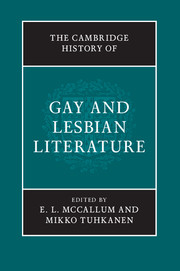
- Cited by 1
-
Cited byCrossref Citations
This Book has been cited by the following publications. This list is generated based on data provided by Crossref.
Medd, Jodie 2015. The Cambridge Companion to Lesbian Literature.
- Publisher:
- Cambridge University Press
- Online publication date:
- December 2014
- Print publication year:
- 2014
- Online ISBN:
- 9781139547376
- Collection:
- Cambridge Histories - Literature


